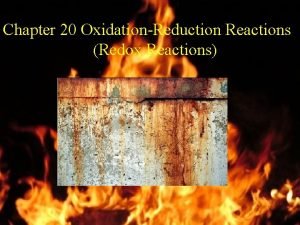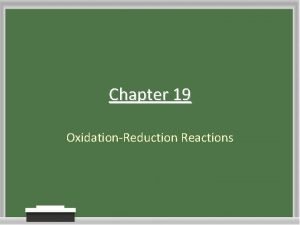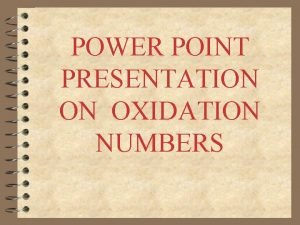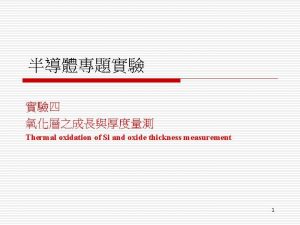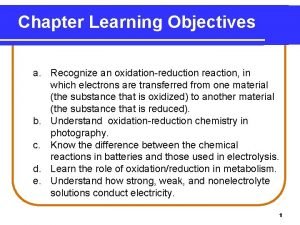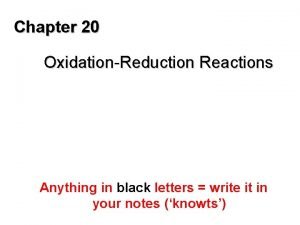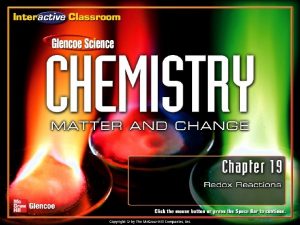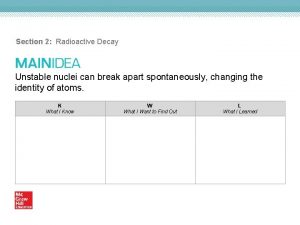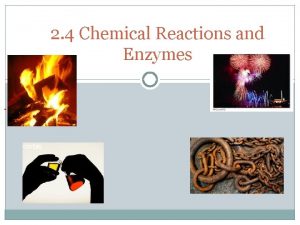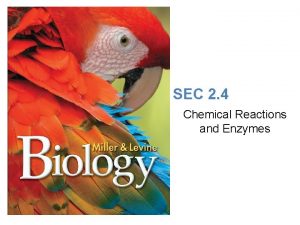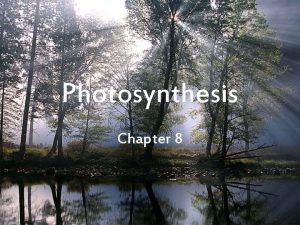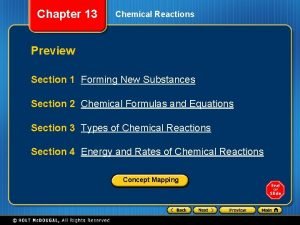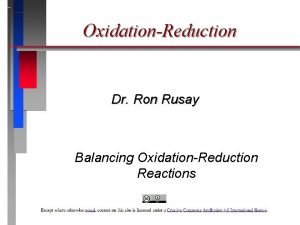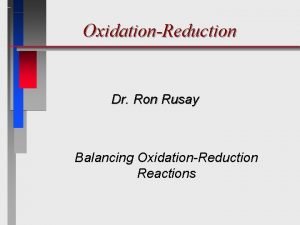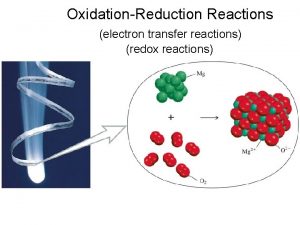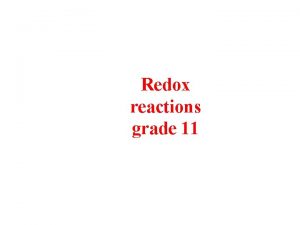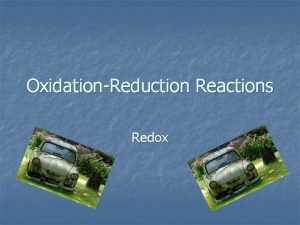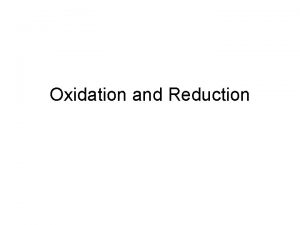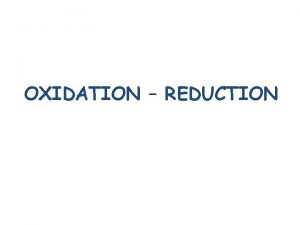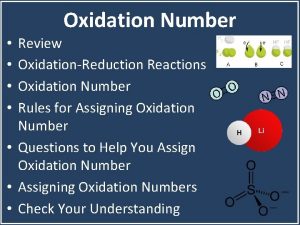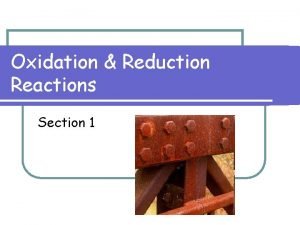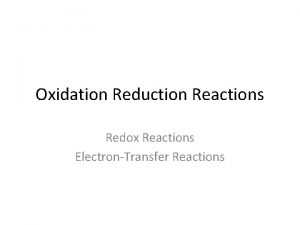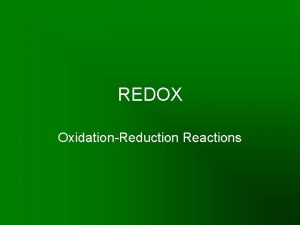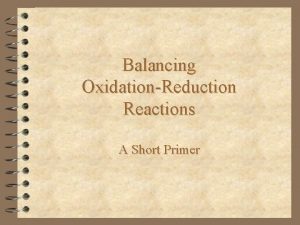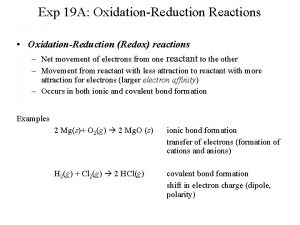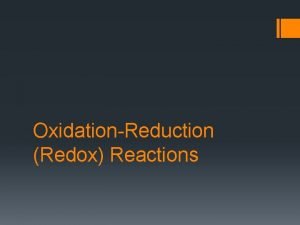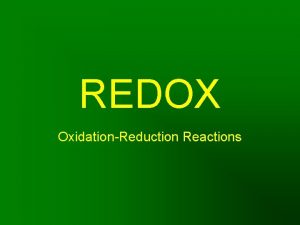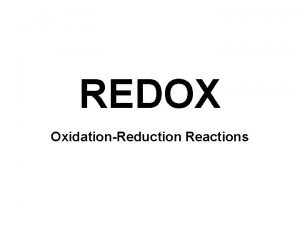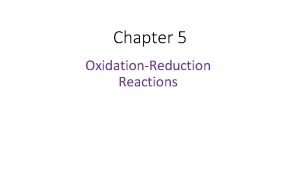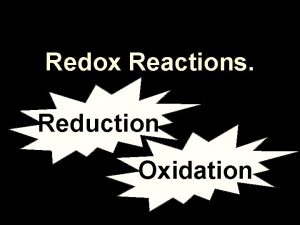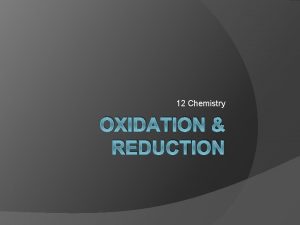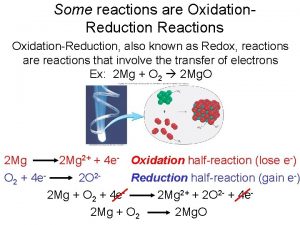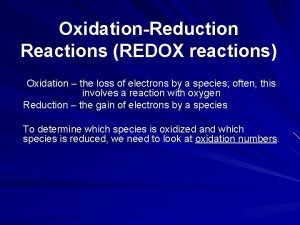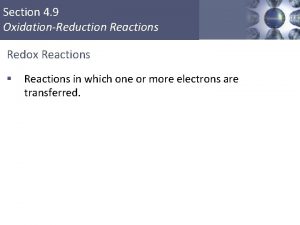Chapter 19 OxidationReduction Reactions Section 1 Oxidation and
































- Slides: 32

Chapter 19 Oxidation-Reduction Reactions

Section 1: Oxidation and Reduction • Standard 3. g. : – Students know how to identify reactions that involve oxidation and reduction and how to balance oxidation-reduction reactions. • Objective: – We will assign oxidation numbers to reactant and product species and explain what an oxidation-reduction reaction is.

Oxidation States • The oxidation number assigned to an element in a molecule is based on the distribution of electrons in that molecule. • Rules for Assigning Oxidation Numbers are in Table 1 on page 631. Oxidation Worksheet Examples on back of Homework Stamp Sheet

Rules • • The oxidation number of any pure element is 0. The oxidation number of a monatomic ion equals that charge on the ion. The more electronegative element in a binary compound is assigned the number equal to the charge it would have if it were an ion. The oxidation number of fluorine in a compound is always -1.

• • • Oxygen has an oxidation number of -2 unless it is combined with F, in which it is +1 or +2, or it is in a peroxide, in which it is -1. Hydrogen is +1, unless combined with a metal, then it is -1. In compounds, Group 1 is +1, Group 2 is +2, and Aluminum is +3. The sum of the oxidation numbers of all atoms in a neutral compound is 0. The sum of the oxidation numbers in a polyatomic ion equals the charge of the ion.

Oxidation States of Chromium • Orange – K 2 Cr 2 O 7 Potassium Dichromate • Yellow – Na 2 Cr. O 4 Sodium Chromate • Green – Cr. Cl 3 Chromium(III) Chloride • Violet – Cr(NO 3)3 Chromium(III) Nitrate

Oxidation • The processes in which the atoms or ions of an element experience an increase in oxidation state. 2 Na(s) + Cl 2(g) 2 Na. Cl(s) • The formation of sodium ion illustrates an oxidation process because each sodium atom loses an electron to become a sodium ion. Na Na+ + e • Sodium is considered oxidized because it increased in oxidation number.

Reduction • The processes in which the oxidation state of an element decreases. • The formation of a chloride ion illustrates a reduction process because each chlorine atom gains an electron to become a chloride ion. Cl 2 + 2 e- 2 Cl • Chlorine is considered reduced because it decreased in oxidation number.

Oxidation and Reduction as a Process • Any chemical process in which elements undergo changes in oxidation number is an oxidation-reduction reaction or redox reaction for short. • The part of the reaction involving oxidation or reduction alone can be written as a halfreaction.

“Leo the Lion says Ger” • LEO = Loss of Electrons Oxidation • GER = Gain of Electrons Reduction

Examples Identify the following as Oxidation or Reduction: 1. K K+ + e 2. S + 2 e- S 23. Mg 2+ + 2 e 4. 2 F- F 2 + 2 e 5. O 2 + 4 e- 2 O 26. Mn 2+ Mn. O 4 - + 5 e-

Examples Identify the following as Oxidation or Reduction: 1. K K+ + e. Oxidation 2. S + 2 e- S 23. Mg 2+ + 2 e 4. 2 F- F 2 + 2 e 5. O 2 + 4 e- 2 O 26. Mn 2+ Mn. O 4 - + 5 e-

Examples Identify the following as Oxidation or Reduction: 1. K K+ + e. Oxidation 2. S + 2 e- S 2 Reduction 3. Mg 2+ + 2 e 4. 2 F- F 2 + 2 e 5. O 2 + 4 e- 2 O 26. Mn 2+ Mn. O 4 - + 5 e-

Examples Identify the following as Oxidation or Reduction: 1. K K+ + e. Oxidation 2. S + 2 e- S 2 Reduction 3. Mg 2+ + 2 e. Oxidation 4. 2 F- F 2 + 2 e 5. O 2 + 4 e- 2 O 26. Mn 2+ Mn. O 4 - + 5 e-

Examples Identify the following as Oxidation or Reduction: 1. K K+ + e. Oxidation 2. S + 2 e- S 2 Reduction 3. Mg 2+ + 2 e. Oxidation 4. 2 F- F 2 + 2 e. Oxidation 5. O 2 + 4 e- 2 O 26. Mn 2+ Mn. O 4 - + 5 e-

Examples Identify the following as Oxidation or Reduction: 1. K K+ + e. Oxidation 2. S + 2 e- S 2 Reduction 3. Mg 2+ + 2 e. Oxidation 4. 2 F- F 2 + 2 e. Oxidation 5. O 2 + 4 e- 2 O 2 Reduction 6. Mn 2+ Mn. O 4 - + 5 e-

Examples Identify the following as Oxidation or Reduction: 1. K K+ + e. Oxidation 2. S + 2 e- S 2 Reduction 3. Mg 2+ + 2 e. Oxidation 4. 2 F- F 2 + 2 e. Oxidation 5. O 2 + 4 e- 2 O 2 Reduction 6. Mn 2+ Mn. O 4 - + 5 e. Oxidation

Redox Reactions • In order for a reaction to be a redox reaction, the atoms in the reaction must change oxidation state. If they don’t, it is not a redox reaction. 0 0 1+ 1 - • Redox: 2 Na + Cl 2 2 Na. Cl 4+ 2 - 1+ 4+ 2 - • Not Redox: SO 2 + H 2 O H 2 SO 3

Homework Chapter 19. 1 pg 635 #2 -4 and Oxidation Worksheet

Section 2: Balancing Redox Equations • Standard 3. g. : – Students know how to identify reactions that involve oxidation and reduction and how to balance oxidation-reduction reactions. • Objective: – We will balance redox equations by using the half-reaction method

Balancing Redox Equations • In a normal equation, when we balance, we are only conserving mass, we are not looking at charge. • In a Redox Equation, when properly balanced, both mass and charge are conserved.

Half-Reaction Method Consists of 7 steps: 1. Write the formula equation, if not given, and then write the net ionic equation. 2. Assign oxidation numbers and delete substances containing only elements that do not change oxidation state. 3. Write the half-reaction for oxidation, balance atoms, and balance charges.

4. Write the half-reaction for reduction, balance atoms, and balance charges. 5. Conserve charge by adjusting the coefficients in front of electrons so that the number lost equals the number gained. 6. Combine the half-reactions and cancel out anything common to both sides of the equation. 7. Combine ions to form compounds shown in the original formula equation. Check all ions are balanced.

• When doing ionic equations, do not break up the covalent compounds. • Covalent Compound consists of 2 or more non -metals!!!!!

Example • Copper reacts with hot, concentrated sulfuric acid to form copper(II) sulfate, sulfur dioxide, and water. Write and balance the equation for this reaction. Step 1: Write Formula and Ionic Equations Formula: Cu + H 2 SO 4 Cu. SO 4 + SO 2+ H 2 O Ionic: Cu + 2 H+ + SO 42 - Cu 2+ + SO 42 - + SO 2 + H 2 O

Step 2: Assign Oxidations Numbers and Delete 0 1+ 6+ 2 - 2+ SI 4+ 2 - SI Cu + 2 H+ + SO 42 - Cu 2+ + SO 42 - + SO 2 + H 2 O Delete things that don’t change oxidation state and SI. Cu + 2 H+ + SO 42 - Cu 2+ + SO 42 - + SO 2 + H 2 O Cu + SO 42 - Cu 2+ + SO 2 Step 3: Write Oxidation Half-Reaction Cu 2+ Atoms are balanced, look at charges 0 2+ Cu 2+ + 2 e-

Step 4: Write Reduction Half-Reaction SO 42 - SO 2 Need to balance Oxygen, so add H 2 O as needed SO 42 - SO 2+ 2 H 2 O Need to balance H now, add H+ as needed SO 42 - + 4 H+ SO 2+ 2 H 2 O Now balance charges, 6+ 4+ on Sulfur SO 42 - + 4 H+ + 2 e- SO 2+ 2 H 2 O

Step 5: Conserve charge by adjusting the coefficients in front of electrons so that the number lost equals the number gained. Electron charge are equal so SKIP! Step 6: Combine Half-Reactions and Cancel Cu 2+ + 2 e. SO 42 - + 4 H+ + 2 e- SO 2+ 2 H 2 O Cu + SO 42 - + 4 H+ + 2 e- Cu 2+ + 2 e- + SO 2+ 2 H 2 O

Step 7: Combine ions to form compounds Cu + SO 42 - + 4 H+ Cu 2+ + SO 2+ 2 H 2 O Need a SO 42 - to bond with Cu 2+, must add to both sides, which uses up the 2 extra H+ Cu + 2 H 2 SO 4 Cu SO 4 + SO 2+ 2 H 2 O Check all elements are balanced and then YOU ARE DONE!!!

• If a redox reaction is happening with a base rather than an acid, sometimes you will need to add H 2 O and OH rather than H 2 O and H+

• Let’s do another one: K 2 Cr 2 O 7 + HCl + C 2 H 5 OH Cr. Cl 3 + CO 2 + KCl + H 2 O

Homework Chapter 19. 2 pg 641 #1 -3
 Section 2 classifying chemical reactions worksheet answers
Section 2 classifying chemical reactions worksheet answers Section 2 classifying chemical reactions
Section 2 classifying chemical reactions Chemical reactions section 3 reactions in aqueous solutions
Chemical reactions section 3 reactions in aqueous solutions Chapter 19 review oxidation-reduction reactions
Chapter 19 review oxidation-reduction reactions Chapter 20 worksheet redox
Chapter 20 worksheet redox Chapter 19 review oxidation-reduction reactions answers
Chapter 19 review oxidation-reduction reactions answers Oxidation examples
Oxidation examples Dry oxidation wet oxidation
Dry oxidation wet oxidation Redox reaction
Redox reaction Half redox reaction
Half redox reaction Oxidation–reduction reactions
Oxidation–reduction reactions Leo the lion says ger
Leo the lion says ger Oxidation reduction reactions
Oxidation reduction reactions Chemical equations and reactions chapter 8 review
Chemical equations and reactions chapter 8 review Chapter 8 section 1 chemical equations and reactions
Chapter 8 section 1 chemical equations and reactions Example of oxidation reduction reaction
Example of oxidation reduction reaction Chemistry unit 5 reactions balancing reactions worksheet
Chemistry unit 5 reactions balancing reactions worksheet Nuclear decays and reactions section 2
Nuclear decays and reactions section 2 Section 2-4 chemical reactions and enzymes
Section 2-4 chemical reactions and enzymes What is released or absorbed whenever chemical
What is released or absorbed whenever chemical Section 2-4 chemical reactions and enzymes
Section 2-4 chemical reactions and enzymes Chapter 10 chemical reactions
Chapter 10 chemical reactions Chapter 9 chapter assessment chemical reactions
Chapter 9 chapter assessment chemical reactions Combination reaction equation
Combination reaction equation Chemical reactions section 1 chemical changes
Chemical reactions section 1 chemical changes Section 8-1 energy and life
Section 8-1 energy and life Section 8-3 the reactions of photosynthesis
Section 8-3 the reactions of photosynthesis Section 1 atoms elements and compounds
Section 1 atoms elements and compounds Chapter 6 chemistry in biology
Chapter 6 chemistry in biology Section 2 chemical reactions answer key
Section 2 chemical reactions answer key Balancing equations chapter 8
Balancing equations chapter 8 Chapter 10 section 1: meiosis
Chapter 10 section 1: meiosis Chapter 9 chemical reactions
Chapter 9 chemical reactions




